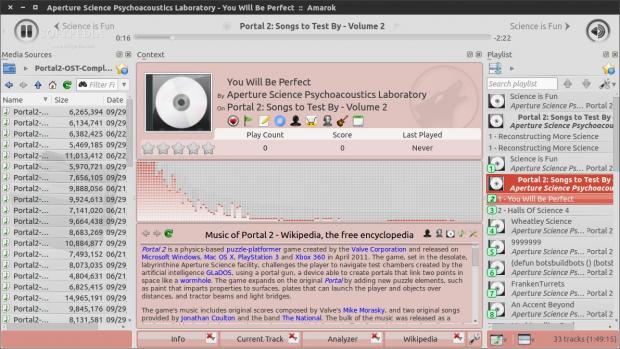Amarok is one of the most famous music players on the Linux platform and it's been around for more than a decade. It's integrated by default in KDE, which might have contributed to its fame, but it's definitely one of the most interesting alternatives.
Amarok has been a part of the Linux community since 2003 and it changed a lot in all those years, but one thing remained the same, its style. The software has a particular look that sets it apart from all the rest and is definitely doing things differently from the flock.
There are numerous media player applications on the Linux platform and all of them are fighting for the crown, and this means that a piece of software needs to be really good in order to even be considered for installation.
Amarok is predominantly installed on KDE-powered systems, but the application is distributed outside KDE as well, not to mention the fact that it also works on Windows and Mac OS.
Installation
Installing Amarok is actually pretty simple because it is present in most of the repositories, so that means that you won't have to do anything special. We tested the software in Ubuntu 14.04 LTS and you can find the latest version of the application in Ubuntu Software Center.
If you don't want to use Ubuntu Software Center, you can do it the old-fashioned way and enter a command in a terminal (you will need to be root):
sudo apt-get install amarok
If you are not in KDE-powered system, it will take a while until all the dependencies are installed, so be patient.
Usage
Amarok is not your typical music player and that is obvious right from the start. The main window of the software doesn't look like any of its competitors. If you are used to apps like Rhythmbox or Clementine, this will be a surprise.
The bulk of the window is occupied by information about the current song, right in the center. The name of the track, musician, and the album are shown with big letters on top. Right below that information, you will find a number of buttons like “Add position marker,” “Edit track details,” “Search for artist in MP3 Music Store,” and a few others.
Right below that, there is a huge visualization thingy that is there just for show. The user can change it to another model or he can disable it completely.
At the bottom of the application, the developers have integrated a default Wikipedia search, which seems to work rather well. You will need to be connected to the Internet to make it work, but that is to be expected.
The left side of Amarok is reserved to music sources, like Local, Internet (Last.fm, Jamendo, and a few others), Podcasts, and a simple file browser. The right side of Amarok is for the playlist for whatever source has been selected.
All the other features that you would expect from a media player are also integrated, like an equalizer, a cover manager, and even a bookmark manager.
The power of Amarok is in its plugins. Most of what you see in the interface is in fact a plugin working inside the application, but there are also a number of configurable scripts, and those are abundant on the Internet, if you want to configure the application even more.
The Bad
Also, Amarok uses its own notification bubbles, but it's hard to call them bubbles. It's a wide notification that appears on top of the application and it's just too big (it can be disabled). Not to mention the fact that the Play and Pause button reacts very slowly to the commands.
The Good
Amarok is also pretty configurable, if you can get your head around it, and that default use of space can be changed to something else entirely.
 14 DAY TRIAL //
14 DAY TRIAL // 









